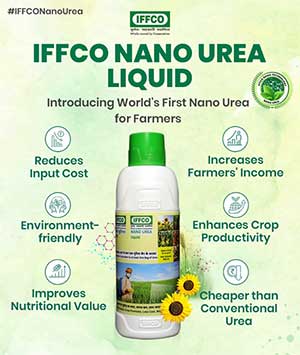Date : 19/06/2023
Relevance – GS Paper III – Indian Economy – Agriculture – Subsidy
Keywords – Indian Farmers and Fertiliser Cooperative (IFFCO), Crop yield, Crop Stimulation mechanism
Context :
Nano liquid urea, developed by the Indian Farmers and Fertiliser Cooperative (IFFCO), was introduced as a potentially cost-effective and yield-enhancing alternative to traditional granular urea. However, recent ground visits and farmer testimonials have raised doubts about its efficacy and impact on crop growth.
I. Nano Liquid Urea: An Alternative to Traditional Urea
- Nano urea claims to contain nitrogen in granules a hundred-thousand times finer than a sheet of paper.
- Promoted by the central government as a substitute for traditional urea.
- Marketed as a more cost-effective option with the potential to increase farm yields.
II. Farmers' Experiences: Lack of Visible Benefits
- Farmers who experimented with nano liquid urea reported no visible benefits on their crops.
- Some farmers from Madhya Pradesh observed no change in fields treated with nano urea compared to conventional urea.
- Some farmers from Sonipat resorted to applying traditional fertilizers due to the ineffectiveness of nano urea.
III. Uncertain Impact on Crop Yield
- The first trial of nano liquid urea showed no significant effects on agricultural yield but reduced urea usage by 50%.
- Crop stimulation mechanism remains unclear, according to former Director General of DARE, Trilochan Mohapatra.
- Parliamentary Standing Committee report claims a 50% reduction in the burden of subsidized urea and an 8% increase in yield with nano urea.
IV. Farmer Concerns and Yield Loss
- Ground visits by Down To Earth (DTE) revealed that farmers experiencing yield loss due to untimely rain were dissatisfied with nano urea.
- Expensive and ineffective, farmers faced 30-40% yield losses despite using the product.
- Pawan from Haryana experienced no significant impact on crop production despite using nano urea.
V. Mixed Opinions among Scientists
- A scientist associated with Kisan Vigyan Kendra reported no noticeable results from personal trials with nano urea.
- Scientists from the Indian Council of Agricultural Research (ICAR) highlighted the absence of negative effects on crop production.
VI. Declining Export Demand
- IFFCO received permission to export nano urea to Sri Lanka but faced a significant decline in demand.
- Export figures dropped from 306,000 bottles in 2021-22 to 158,000 bottles in 2022-23.
Conclusion:
While nano liquid urea was initially positioned as a promising substitute for traditional urea, the ground reality suggests limited visible benefits on crop growth. Farmers' experiences, coupled with mixed opinions among scientists, raise concerns about the effectiveness of nano urea. The reduction in export demand further emphasizes the need for comprehensive research and evaluation to determine its practicality and potential impact on agriculture.
Probable Question for UPSC Mains Exam:
- Question 1. "Examine the effectiveness of nano liquid urea as a substitute for traditional urea in the context of Indian agriculture. Discuss the farmer experiences, scientific opinions, and export demand to present a comprehensive evaluation of its impact on crop growth." (10 Marks, 150 Words)
- Question 2. "Critically analyze the challenges and concerns associated with the adoption of nano liquid urea as an alternative to traditional urea in Indian agriculture. Discuss the lack of visible benefits reported by farmers, conflicting scientific opinions, and the decline in export demand as factors that raise doubts about its efficacy. Suggest possible measures to address the limitations and ensure effective utilization of nano urea." (15 Marks, 250 words)
Source- DTE








